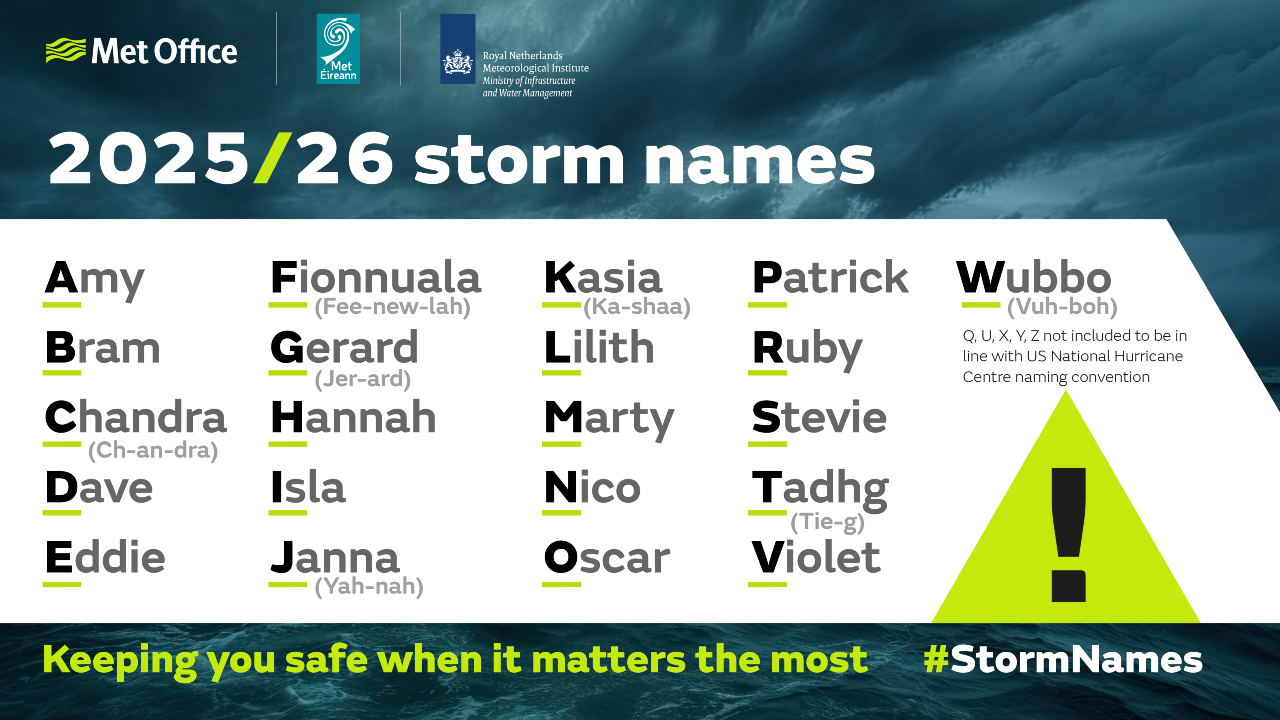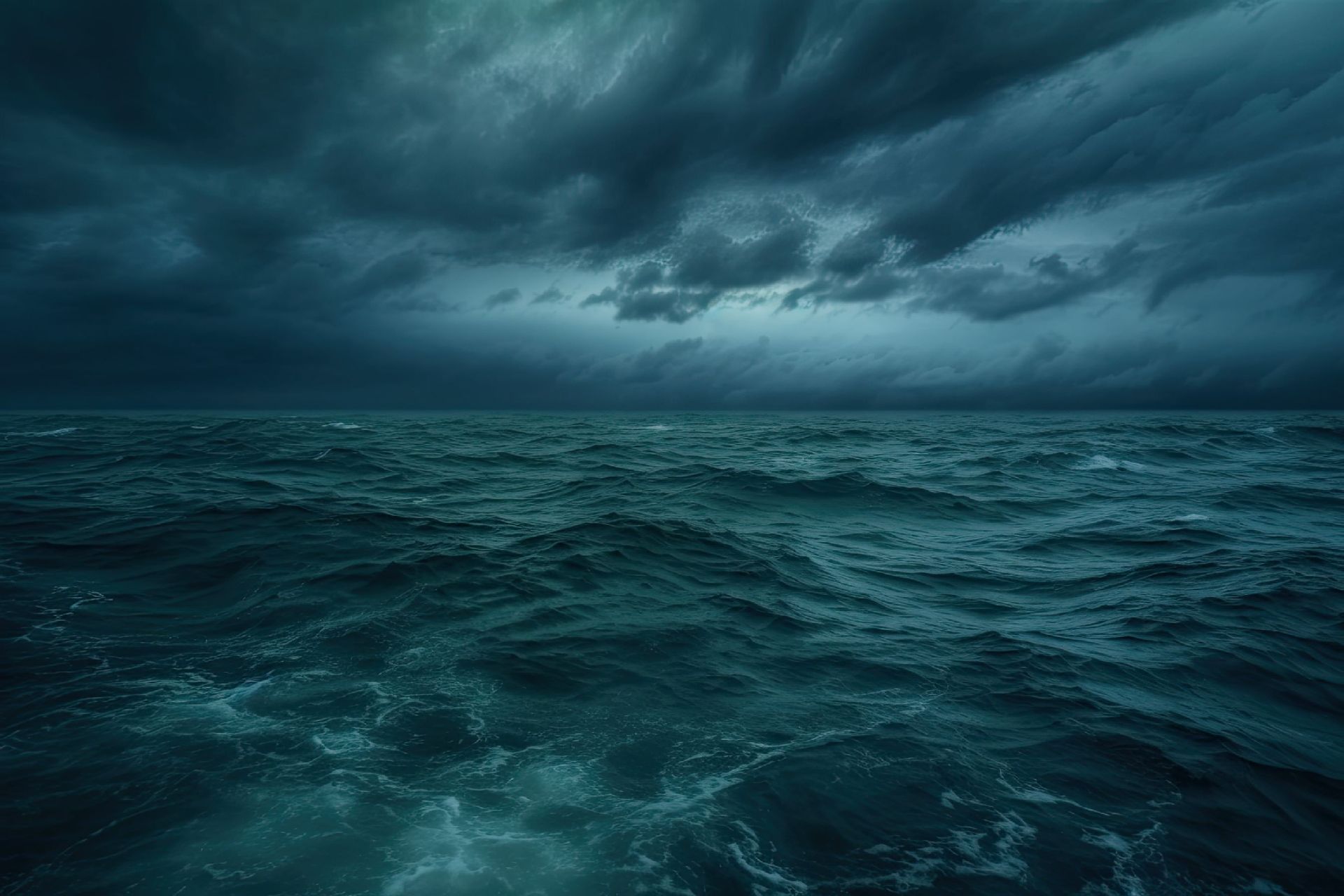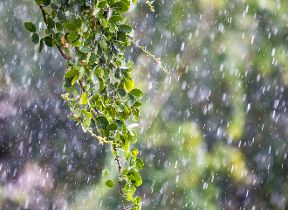Public picks storm names in tribute to loved ones and pets
Author: Press Office
00:01 (UTC+1) on Mon 1 Sep 2025
The Met Office, in partnership with Met Éireann and KNMI, has revealed the storm names for the 2025-26 season and this year, every single one has been submitted by the public.

The Met Office, in partnership with Met Éireann and KNMI, has revealed the storm names for the 2025-26 season and this year, every single one has been submitted by the public.
From Cornwall to County Down, to the Netherlands and Ireland, more than 50,000 suggestions were submitted. The final list reflects not only popular choices, but also the deeply personal stories behind them, with tributes to loved ones, cherished pets, and everyday heroes.
- Amy, Bram and Chandra will be the first three named storms by the group this season.
- All contributions, from Met Office, KNMI and Met Éireann, have been submitted by the public.
- Naming storms helps to communicate the risks of severe weather.
The first name on the list - Amy - was the most popular female name submitted to the Met Office. It resonated with many who associated it with loved ones, one submission read: “[My family] love being outside, whether in the garden or walking/ cycling/scooting to school or the park. So the first thing we do each morning with breakfast is to check what the weather forecast is for the day.”
Other names submitted to the Met Office include Dave, described as “my beloved husband who can snore three times louder than any storm!”; Isla, the most popular ‘I’ name, with many submissions about little girls who leave chaos in their wake. And Violet, a daughter “every bit as fierce and unstoppable as a storm” after being born at 27 weeks while her mum was unwell.
Stevie was inspired by a little girl named after the Stevie Nicks (Fleetwood Mac) song Dreams, which includes the line: “Thunder only happens when it’s raining.” And Ruby, in honour of a cherished grandmother, and also the most popular name beginning with R.
Pets featured prominently too. One cat, Oscar, was described as “a good boy, but crazy when he gets the zoomies,” while another was remembered fondly for “loving the wind in his fur - he’d sit in the garden for ages just enjoying it.”
"It's about making people take notice..."
While some of the names may bring a smile, the purpose behind storm naming is serious, as Rebekah Hicks, Chief Meteorologist at the Met Office explains: “Naming storms isn’t just about giving them a label, it’s about making sure people take notice.
"When a storm has a name, it becomes easier for the media and public to talk about it, share information, and prepare. It’s a simple step that can make a big difference in helping communities stay safe, protect their homes, and make informed decisions ahead of severe weather.
“We know that naming storms works. We know that for Storm Floris, just a few weeks ago, surveys found that 93% of people in the amber warning area were aware of the alerts, with 83% taking action to prepare.
“Over the past decade, we’ve seen how naming storms helps raise awareness and ultimately, helps save lives. It’s a simple but powerful tool in helping communities stay safe when severe weather is on the way.”
A number of factors are considered for a name to be on the list, including how difficult it might be to pronounce, if it has different meanings across the different countries, if it is connected to a significant public figure and if it could be considered to be controversial in any way.
Read more: How names are chosen blog
Storms will get named by the group when they’re deemed to have the potential to cause ‘medium’ or ‘high’ impacts in the UK, Ireland or the Netherlands. Wind is the primary consideration for naming a storm, but additional impacts from rain or snow will also be considered in the naming process.
The Met Office and partners started naming storms in 2015. The list runs from early September to late August the following year to coincide with the start of autumn and the end of summer, when the likelihood of low-pressure systems and the potential for named storms increase.
How stormy was last season?
The group named six storms in the 2024/25 season, reaching the letter ‘F’ with Storm Floris on 1 August 2025. Storm seasons are highly variable in the UK, with some seasons seeing a low frequency of named storms, and others more. Some seasons, like 2023-24 with its record 12 named storms, are exceptionally active, while others, like 2024-25 are quieter.
Read more about the 2024/25 storm season here.

Eoin Sherlock, Head of Forecasting Division at Met Éireann, said: “Naming storms is a powerful tool that supports us and other public safety organisations to increase awareness of severe and impactful weather alongside our weather warnings.
"We know that naming storms makes it easier for people to track important and up to date forecast and safety-related information. A good example was Storm Éowyn last January, when our website, met.ie received more than 3 million visits in 2 days. This all aids in protecting life and property across Ireland.
"Even though the process of selecting the names was a fun and light-hearted task, ultimately, advising the public of the importance of being prepared for the upcoming storm season, and communicating safety messages for every forecast storm are our highest priorities. At the start of the storm season, we advise everyone to prepare now for possible severe weather events to come.”
Has Climate Change influenced UK storms?
Storm name list in full, with pronunciations and who submitted the names
Amy (Met Office)
Bram (Met Éireann)
Chandra (Ch-an-dra) (KNMI)
Dave (Met Office)
Eddie (KNMI)
Fionnuala (Fee-new-lah) (Met Éireann)
Gerard (Jer-ard) (Met Éireann)
Hannah (KNMI)
Isla (Met Office)
Janna (Yah-nah) (KNMI)
Kasia (Ka-shaa) (Met Éireann)
Lilith (KNMI)
Marty (Met Éireann)
Nico (KNMI)
Oscar (Met Office)
Patrick (Met Éireann)
Ruby (Met Office)
Stevie (Met Office)
Tadhg (Tie-g) (Met Éireann)
Violet (Met Office)
Wubbo (Vuh-boh) (KNMI)
Find out more about storm naming on the UK Storm Centre page.






